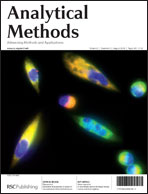A previously reported methodology is applied to monitor the concentration of bacterial suspensions from an incubator using impedance spectroscopy and platinum electrodes. The interface capacitance, commonly fitted as a constant phase element, CPEi, was found sensitive to the suspended bacteria concentration after short exposure times in a wide range of concentrations (from 102 to 107 colony forming units per mL, CFU mL−1) with a limit of detection of 10 CFU mL−1. The effect of the substances released during bacterial growth (enzymes, toxins, exopolysaccharide, etc.) in the CPEi magnitude was found to be negligible and samples only containing cells washed with saline solutions showed results comparable to those obtained using aliquots directly extracted from the bacterial incubator. This impedimetric approach showed correlation with classical microbiological methods for measuring bacterial concentration such as plating onto agar, optical density and fluorescence microscopy. The impedimetric approach was simplified to a single frequency analysis by selecting the optimal frequency for the measurement.

You have access to this article
 Please wait while we load your content...
Something went wrong. Try again?
Please wait while we load your content...
Something went wrong. Try again?


 Please wait while we load your content...
Please wait while we load your content...